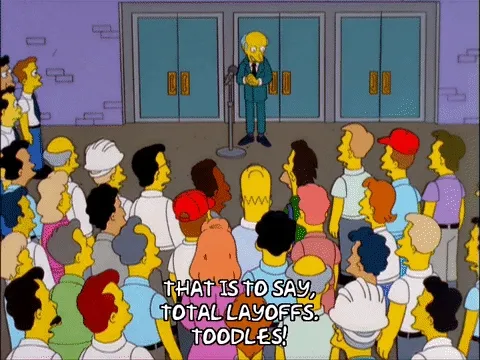HR’s layoff strategy could’ve gone better. Here are some communication lessons for next time
Nobody likes layoffs, but there’s always room for growth in how HR handles them.

The Simpsons/20th Television via Giphy
• 3 min read
Mikaela Cohen is a reporter for HR Brew covering workplace strategy.
It was the best of times, it was the worst of times...The words of Charles Dickens could be used to describe the current state of the economy, but for HR pros conducting layoffs, it’s mostly just the worst of times.
Over 400,000 workers were laid off between 2022 and 2023, according to Layoffs.fyi, an online layoff database, and while there are few hard-and-fast rules for how HR should handle layoffs, one communications expert offered insight into where some have gone wrong in communicating layoffs, and some lessons for next time.
More comms, please. Did you consult with your communications team or an outside comms professional before conducting layoffs? If not, you should have, according to Teal Pennebaker, a founding partner at Shallot Communications.
“[Layoffs] often require an outside person, a comms person, who can come in and be another set of eyes to say, ‘Hey, I hear that you need to get XYZ across, but in order for this to land with employees in a way that feels compassionate, why don’t we consider doing it in ABC way?’” she told HR Brew.
Companies who tend to be more satisfied with their layoff process, Pennebaker added, had a coordinated effort, or “tiger team,” between the CEO, HR, legal, and communications.
Maybe give ’em a heads up. Some 39% of companies that conducted layoffs in the past 18 months didn’t let employees know the cuts were coming, according to a Shallot Communications report provided exclusively to HR Brew.
Companies with 100 or more employees are generally required by law to give a 60-day notice of mass layoffs. But employees, at companies that didn’t give them a heads up, would’ve appreciated it, CBS News reported.
Quick-to-read HR news & insights
From recruiting and retention to company culture and the latest in HR tech, HR Brew delivers up-to-date industry news and tips to help HR pros stay nimble in today’s fast-changing business environment.
When deciding whether or not to give employees notice, remember that what works for one organization may not work for another. One respondent to Shallot’s survey said “letting people know weeks ahead of time that layoffs were coming killed productivity and bred resentment,” while another said a “no surprises approach” to layoffs went over well.
Train managers. Once HR has a game plan, it should train managers on how to discuss layoffs with employees, Pennebaker said.
“Meet with the frontline managers ahead of everyone learning and give them the basics of what they need to know,” she said. Give them written guidance with key messaging and questions they can anticipate from departing employees so they know how to respond.
At a minimum, Pennebaker said HR and all leaders within the company should be able to answer questions like: What are we saying was our rationale for layoffs? How are we explaining what happens next? What severance are we giving? How are we helping those who have been let go?
Have executives share the company’s vision moving forward, and give remaining employees the opportunity to ask questions, Pennebaker said.
“It feels good for nobody to have to go through these,” Pennebaker said. “Your best-case scenario, if you’re an HR or communications leader involved, is that you do things in a way that respects your colleagues who are being let go.”
Quick-to-read HR news & insights
From recruiting and retention to company culture and the latest in HR tech, HR Brew delivers up-to-date industry news and tips to help HR pros stay nimble in today’s fast-changing business environment.